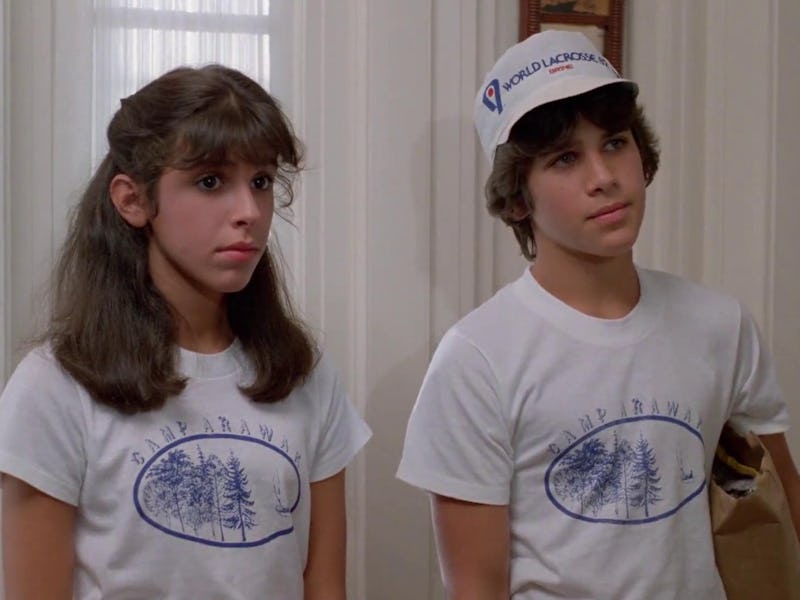The Most Shocking Horror Movie of the 1980s Is Also Complicated to Revisit
The real horror comes from remembering life during the Reagan years.

For every iconic slasher classic of the ’80s, there were a dozen hokey cash-ins easily identified by ridiculous titles like The Slumber Party Massacre and Chopping Mall. And then, unique among all this forgettable crud, there was Sleepaway Camp.
On its surface, the 1983 movie looks very much like your typical D-list slasher. But it stood apart from the decade’s other cornball horror flicks, garnering sequels and a cult following thanks to its unique tone and surprising, controversial, and heavily analyzed ending.
On one level, Sleepaway Camp is your typical horror story of a serial murderer running around slaughtering campers and counselors. But what makes the movie both terrifying and creative is how it captures the horror of being a middle schooler.
After an opening sequence that sees a man named John and his son, Peter, lose their lives in a boating accident, we jump to John’s surviving child, Angela, and her cousin, Ricky, being shipped off to Camp Arawak by Angela’s aunt. Angela is still haunted by the tragedy, and summer camp doesn’t do the awkward tween any favors: she’s bullied by camper and counselor alike, with even the cook trying to molest her.
Unlike most horror films, where the teenagers are 16 or 17, the main characters of Sleepaway Camp are clearly supposed to be just 13 or 14 years old. That’s a tough age to be stuck in an environment without the comforts and privacy of home, and there’s a certain grim novelty in seeing middle school kids become the victims of a ruthless and inventive slasher.
Judy bullies Angela at a championship level by trying to steal away her crush.
That’s also the age when hormones are running wild, and kids are trying to act like adults while having absolutely no idea what they’re doing. Sleepaway Camp doesn’t hold back in portraying these kids as awkward and unpleasant in their attempt to enjoy a taste of freedom from proper adult supervision. It’s both jarring and hilarious to see such raunchy, foul-mouthed behavior coming from kids who look like they only recently lost interest in Saturday morning cartoons.
Camp Arawak is lawless. The counselors are neglectful and abusive, the forced group bonding activities are awful. The sullen and introverted Angela is a perpetual target for bullies, with only her protective cousin there to guard her with his smarts, physicality, and college-level grasp of obscenities.
As both bodies and romantic drama pile up, it becomes clear that the scaldings and drownings dismissed as accidents have been anything but. Angela’s bullies are dropping dead at a rapid clip, and from all manner of ridiculous and brutal contrivances. Eventually, it becomes clear that Ricky has gone way too far on his mission to defend Angela... but then there’s the “shocking” twist.
Ricky is Angela’s one true friend.
Not only is Angela the real murderer, but the opening accident is cast in a new light. John’s son was the real survivor, but John’s sister, having always wanted a daughter, forced him to live as Angela. Just in case that’s not problematic enough, it’s also implied that Angela snapped after seeing her closeted father in bed with another man.
In 1983, this was considered a wild, jaw-dropping twist. Today, it’s hard to watch without seeing elements of homophobia and transphobia. A wide variety of LGBT commentators have intelligently analyzed Sleepaway Camp; in some ways, it was ahead of its time, and in others, it can be a difficult watch. Trans writer Calpernia Addams concluded it was “a schlocky ’80s horror with a unique twist ending,” one that can still be an “enjoyable watch.”
That seems like a fair conclusion. Sleepaway Camp was clearly written by cisgender people in an era when there was very little understanding of the trans community, but the big reveal doesn’t change how you see Angela; it just makes you realize she was failed by everyone around her. As modern slashers like They/Them are made by LGBT creators for LGBT fans, ’80s curiosities like Sleepaway Camp can be watched with a critical eye, while still enjoyed for their absurdity. It’s good that we left the ’80s behind, but dropping in for 90 minutes can be fun.